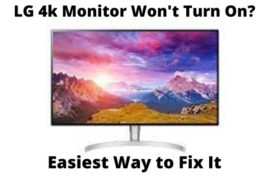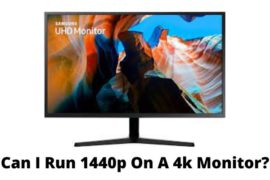The screen resolution, size, and color are the key aspects to consider while purchasing a new PC monitor. Another most essential technical aspect that one has to decide is whether to choose the lower or higher response time.
But what is response time, and why does it matter so much?
The response time in the monitor determines how long the monitor takes to shift one color to another, which is mainly measured in milliseconds. Whether you should choose higher or lower Response time depends on your purpose of monitor use.
In today’s article, I will be explaining everything one needs to know before deciding which monitor response time is better for them.
What Does Response Time In Monitor Mean?
Response time of any PC, computer or gaming monitor mainly refers to the time duration that the monitor takes to react to the change in the display.
It might sound complicated so let me explain it a little simpler-
Monitor Response time is also known as the pixel response time which refers to the amount of time it takes for pixel transitions.
Therefore, whenever you see any colorful visual or image, it is the outcome of individual color pixels change.
More specifically speaking response time means the time any monitor takes for transitioning from one pixel to another like from black to white and then back to black again or from one gray shade to another gray shade.
That means measuring the time duration a monitor endures to change one color pixel to another to display colorful visual images on the screen.
This color shifting or transitioning process mainly happens very quickly like within a blink of an eye. That’s why the monitor’s response time is measured in Millisecond or “ms”, which refers to the time unit equal to one-thousandth of a second.
Even the time length of black to white pixel transition is considered as the “True” monitor response time and reportedly, the gray shade to gray pixel transition is a marketing strategy that mainly indicates that the monitor has a little higher black to white response time than the standard.
Why Does Response Time In Monitor Matter?
Monitor’s response time is one of the most crucial specs to consider since it determines how fast or quick a pixel can change the color, which primarily affects the accuracy and clarity of the displayed image on the screen.
Remember, a good or quality response time will ensure smooth and better visual quality by minimizing the barriers between the character and you.
Now, you might ask How exactly does Response Time benefit?
For instance, more or less everyone is aware of the fact that a higher quality monitor means it is supposed to have a better visual display and high performance.
To achieve that smoother and better visual quality, your monitor must contain the perfect response time.
Reportedly, the lower the response time of your monitor, the better since the lower response time (1ms) effectively minimizes image processing, monitor blurring, and ghosting.
Especially for gaming enthusiasts and lovers, every single millisecond counts and no one prefers delays or blurry images while they are in the middle of the live competitive games.
So, if you are looking for a new monitor for gaming, you should consider the best response time before sorting your options based on other key aspects.
What Are The Most Common Monitor Response Times?
A Good responsive monitor will allow you to enjoy lag-free official work, such as typing, online browsing, sharing, as well as playing competitive games, and watching movies.
There are different response times widely available response times for monitors, and reportedly, 1ms, 2ms, 3ms, 4ms, and 5ms are the common and more acceptable response times.
Which One Is Better: Lower or Higher Response Time in Monitor?
The final decision should only be made by the person who is purchasing the monitor yet I can at least help you understand which one works better for which type of purpose.
In most cases, people purchase monitors without even considering the response time it has or get confused between the monitor’s refresh rate and response time.
Do not get confused between the Refresh Rate and the Response Time. Since Refresh rate refers to the number of frames your monitor can show in a single second, the higher the rate is, the better.
But it does not work the same way with the monitor’s response time. Why?
When you have a higher response time on your PC monitor, it will struggle to show fast-moving objects clearly, and you will notice more visible motion blur during fast camera movements.
But lower response time makes the displayed images look much smoother and more responsive to movement.
When the response time is lower, it moves faster and delivers a crystal clear, smooth viewing experience.
That means the monitor’s response time should be lower and preferably 1ms. But up to 5ms is still acceptable.
But depending on which type of display panel or technology is used on your selected brand’s monitor, the lowest response time will vary.
Currently, the most commonly used display technology or panels on monitors are Twisted Nematic (TN), In-Plane Switching (IPS), and Vertical Alignment (VA) screen panels-
- Among these three, TN is the fastest display panel, which offers the lowest 1ms response time.
- IPS screen panel can offer 4ms lowest response time, which is still acceptable.
- Although the VA display panel usually has higher responsiveness compared to the other two options, if you are not a competitive gamer up to 5ms will still be acceptable.
For more in-depth knowledge of popular monitor display types, how each of them differs from each other, and learn which one can be the ideal choice for you, read https://www.thedisplay.blog/monitor-display-types/ and https://www.gadgetreview.com/best-monitor-panel-type.
What Is the Best Monitor Response Time For Gaming?
Monitor’s responsiveness highly matters when you are only looking for a monitor to play competitive games.
The ideal choice should be hunting either 1ms or 2ms response time if you wish to enjoy an immersive gaming experience on it.
The first preference should be to look for a monitor with less than 5ms response.
The next recommendation for competitive gamers is, to choose a monitor with TN panels, which will ensure the fastest response and best performance.
But remember, TN screen panels tend to deliver washed-out colors and poor viewing angles.
If you choose the IPS panel, you will get better color and visual outcomes, but it will deliver a slower response time and prevent you from enjoying competitive gaming.
Therefore, it’s up to you to think thoroughly and then decide which panel you should go for, but be sure to choose the lower response time.
Which One Is Better: 1ms or 5ms Response Time?
Since the lowest response time ensures zero image blurring and ghosting chances if you ask which one is the best, I will answer 1MS is.
But remember, 5ms response time is ideal for other tasks such as online browsing, typing, file sharing, and casual video gaming.
Therefore, you should decide based on your actual purpose for using the new monitor.
Conclusion
When determining the quality of a monitor before purchasing the new one, everyone is well aware of choosing the monitor with a better visual display and high performance.
But very few are aware of considering the response time or responsiveness of the monitor and exactly it matters. They are unaware of the importance of better response time in the monitor.
So, what do you think is the higher response time in monitors better or the lower?
Sources:
- https://www.technochops.com/monitors/3919/is-4ms-response-time-good/
- https://www.gadgetreview.com/best-response-time-for-gaming
- https://www.newegg.com/insider/what-is-response-time-monitors-displays/
- https://www.gfinityesports.com/tech/what-is-a-good-response-time-for-a-gaming-monitor/
Related Posts:




